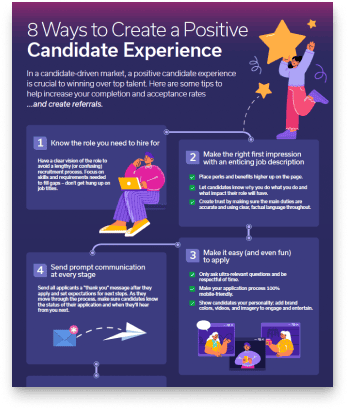
The Ultimate Networking Guide for Job Seekers
A guide to effective networking in 2024. Find out how to build and nurture genuine professional connections to boost your career.

Want happy, productive employees and a standout organizational culture? Start by creating a positive candidate experience. In a candidate-driven market, it’s more important than ever to consider your recruitment process from the candidate’s perspective.
Learn why the candidate experience is valuable, ways to create a great candidate experience, and how you can benchmark success.

The candidate experience is how a person feels as they go through a company's hiring process—from the moment they read the job description. It’s one of the most important factors for attracting talent and has the power to impact whether or not a candidate will apply or accept a job.
A candidate’s experience, character, and skills are becoming more important than ever.. Why? The employer-candidate relationship has seen a power shift in the past decade, especially with the great “re-shuffling” as the pandemic rewrote corporate recruiting rulebooks.
Historically, employers were able to call the shots during the hiring process. Now, this power has shifted to the candidates.
A good candidate experience is necessary to find hires.
A great candidate experience, on the other hand, helps you win over top talent, and benefits your recruiting strategy.
When you take your recruitment strategy from good to great, you’ll:
Stand out from the competition
Candidates are likely applying to several companies at the same time. The job titles, locations, salary, and perks may be very comparable on paper. How a candidate is treated throughout the hiring process can be the make or break for their decision. If the candidate gets more than one job offer, their hiring experience could very likely be part of their deciding factor.
See a better completion rate
Candidates who start an application and feel supported and acknowledged throughout their hiring process are far more likely to see it through to the end. Candidates may disappear during the application process (otherwise known as ghosting) due to a lack of communication or a disorganized hiring process.
Get a higher acceptance rate, faster
Candidates who were happy with their hiring experience are far more likely to confidently accept an offer, rather than delaying the process for another offer or declining altogether. One survey suggests 89% of candidates would accept a job offer faster if they’re contacted by the recruiter directly.
Notice more people who advocate for your company
Regardless of whether they get hired or not, people will advocate for an organization if they’ve had an outstanding applicant experience. 75% of people actively refuse to accept a job at an organization with a bad reputation.
Stand out from the crowd
Higher completion and acceptance rates
Greater brand advocacy
More referrals and stronger brand reputation
Candidates might decline the role
58% of job seekers have made it all the way through a hiring process, and ultimately decide the role isn’t for them due to a poor experience.
You’ll lose a customer
41% of those who have had a negative candidate experience won’t buy from your brand anymore.
Candidates will share their bad experiences
37% of candidates said they left a negative review online after having a bad hiring experience.
You won’t get repeat candidates
42% of candidates won’t apply for another position at your company if they’ve had a bad experience with you.
It’s not only the candidate who suffers when you fail to provide a positive candidate experience.
60% of candidates talk about their hiring experiences with friends and family, which means their negative experience could potentially have a far-reaching impact on overall brand reputation
A great candidate experience requires work throughout the hiring process. Here’s how you can improve the experience for every candidate by making small changes from the job requisition, all the way through to onboarding:

A hiring process quickly falls apart when the team lacks clarity on what they’re looking for in a candidate. If the vision is unclear, it can cause the recruitment process to be lengthy and disorganized for both you and the candidate.
You may hire the wrong person or possibly end up not hiring anyone. Everyone involved in the hiring should understand the role they’re looking to fill, and what skills are needed. Establishing clarity early on can save time down the line.
Tip: Check out job descriptions for similar roles. Are you asking for too much? Or too little?
First impressions are powerful. Consider your job description as a glimpse into what it could be like to work for your company. How would you like candidates to feel when reading it?
A job description needs to describe more than just responsibilities and requirements.
In a candidate-driven market, you’ll have to answer the golden “What’s in it for me?” question. Here’s how:
Company perks and benefits
What you do, and why it’s important
Accurate job description and necessary requirements
17% of candidates withdraw from the recruiting process because of discrepancies between the job description and their interview.
As a candidate, there’s nothing more frustrating than filling out a lengthy application form, only to then be asked to upload your resume which has the exact same fields included.
Behind the scenes, we know application questions can help with filtering and screening processes, but from a candidate’s perspective, they’ve had to explain themselves twice.
To prevent candidates from clicking ‘X’ halfway through, make it easy to apply by keeping your application simple. Ask focused and relevant questions to show respect for your candidates’ time.
Consider also making your application process totally mobile-friendly, as this widens the applicant pool (nearly 90% of job seekers use a mobile device when looking for a job) and encourages a user-friendly experience.
We’ve covered how to make the application process easy, but what about fun? Some applicant tracking systems allow you to easily add brand colors, videos, and imagery to the applications and careers pages.
Engage candidates by showing what it’s really like to work at your company – use short videos of current employees to share welcoming messages and even record them asking specific questions. Your applicant experience should stand out!
Long application = short applicant list
Completion rates drop by 365% if an application takes longer than 15 minutes.

A personalized candidate experience must involve prompt, timely communication, ideally at each stage of the hiring process. If a candidate has taken the time to fill out an application form, they expect a response.
When faced with radio silence they may assume they filled out the application incorrectly or it failed to go through the system.
Send all applicants a warm “thank you” message after they apply, without delay, that explains you’ve received their application, and send out an automated email (or even SMS) so your team doesn’t need to reach out personally.
Send out a prompt thank you message to set the bar – you’ll need to maintain this level of communication throughout the hiring process. The candidate should be informed of their application status and when they’ll hear from you next.

Your candidates should always know where they are in the hiring process, and what the next steps are. Here are examples:
Hiring stage
Main Message
What to share
Post-application
Thank you for applying!
Outline your hiring process and give a rough timeline of when the candidate can expect to hear from you next.
Pre-interview
Invitation to interview
A time and date for a screening interview, or even better, allow the candidate to pick their own time.
Pre-interview
Reminder of interview
Any extra details to support a candidate’s interview, e.g directions to your office, a blog post about interview tips.
Post-interview
Thank you for your time!
Reiterate your gratitude for their time, and share when they can expect to hear about the outcome.
Post-interview
Interview outcome
Promptly share the outcome, and where necessary, the next steps.
CareerBuilder found that 84% of candidates expect a personal email response acknowledging their application.
To set your organization apart from the competition, create a personalized hiring process. Giving control to the candidate shows a lot about your company – you’re prioritizing their preferences and that you want to provide them with their best version of a hiring process.
Providing a personalized candidate experience is easier than it sounds. A scheduling platform can integrate with work calendars, allowing teams to auto-share real-time availability.
Candidates select an interview based on available time slots. Certain recruitment software allows you to offer candidates the choice of picking their preferred format of interview – say a live video interview, a pre-recorded video interview, or even an in-person interview (where possible) – all based on your team’s availability.
No manual work needed. It’s a win-win – candidates get to pick the type of interview that works best for them, and your team gets to see the best version of the candidate.
Within five minutes, it’s easy to tell if a candidate has prepared for their interview. Similarly, a candidate can detect if their interviewers have done their due diligence.
Without the right preparation, hiring teams may stumble over their interview questions, ask questions clearly answered in their application, or simply seem disengaged.
For a candidate who’s been waiting for the opportunity to interview for your company, this can be a really frustrating and disheartening experience.
Anyone involved in hiring should know how to interview effectively and fairly. Recruiting teams must provide other decision-makers with interview training, and employ a recruiting platform that offers built-in tools to support them during the structured interview:
Candidates want to hear your thoughts, regardless of whether they land the job or not.
Nearly every candidate (94%) wants to receive interview feedback.
However, there’s a big disparity, with only 41% of candidates ever receiving interview feedback before.
Many companies don’t provide feedback for two main reasons.
A good interview experience is still possible, even if the candidate isn’t chosen for the role. By providing constructive feedback, you’re helping to support rejected candidates in their job search. Additionally, these candidates may be more inclined to explore future job opportunities with your organization.
Base it on your rating criteria
Relate back to the job description
Be clear and concise
Focus on qualities that can be improved
A candidate’s experience continues beyond the point when they sign their job offer. Those few weeks between accepting the role and starting at a company can be full of emotions.
How you communicate during this time can really make or break the candidate's experience. Radio silence can be worrying and increase the likelihood of candidate ghosting.
On the other hand, communicating with the candidate too much (e.g. sending training materials, meeting invites, numerous memos that could be shared within the first week) may overwhelm the candidate.
Consider sending them a “starter pack” to welcome them to the team. This will help to create a positive transition from candidate to employee, plus it’s a great opportunity to share your company culture.
Depending on your budget, this could be an email with useful information and friendly messages from the team. Or you could send them a welcome kit, complete with branded swag to help them feel like a member of the team from day one.

The candidate experience is personal to each individual. If you’re only rating the success of a candidate experience from internal observations, you’re missing out on important insights.
How can you benchmark the experience and continue to improve?
After a candidate exits your hiring process, hired or not—send them a survey about their experience.
Keep the questions simple and short – aim for five scale-based or multiple choice questions.
Send surveys to rejected candidates about a week after they’ve exited your hiring process – they will probably give you the most honest feedback after a bit of breathing room. Hired candidates might feel more pressure to be positive.
Tip: Make the surveys anonymous to encourage candid responses.
In your applicant tracking system (ATS), you have access to a lot of real-time data—these statistics help you interpret candidates’ experience:
This information can help you pinpoint specific areas where you can improve, particularly when combined with the results of candidate surveys.
The voices of candidates matter. Their experience with your company can truly make or break their perception of your business and influence the actions of other potential candidates.
In our candidate-first work climate, it’s more important than ever before to provide a great hiring experience for everyone who applies. Even better, by going above and beyond, you’ll stand out, secure top talent, and build a stronger team!

Downloadable Infographic
Tips To Create a Positive Candidate Experience
Get actionable tips that you can implement today!
Candidate experience refers to an applicant’s perceptions of an employer's hiring process. A positive experience can enhance employer brand and improve hiring outcomes.
An ATS streamlines the application process, provides timely updates, and ensures consistent communication, leading to a more efficient and positive experience for candidates.
Providing feedback shows respect for candidates’ time and effort. Constructive feedback can also leave a positive impression, even if the candidate isn’t selected.
Ask applicants for their feedback using surveys. Track application completion and job acceptance rates. Are there dropoffs at a specific stage? Does this vary by department? Also, monitor feedback on review sites. Analyzing this data can help you identify areas for improvement.
Modernize your hiring process with expert insights and advice.